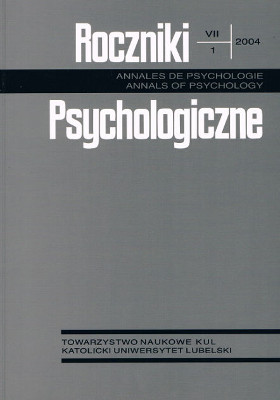Zastosowanie Testu Piramid Barwnych K. Warnera Schaie i Roberta Heissa do oceny sfery emocjonalnej chorych na schizofrenię
Abstrakt
The aim of the work was the evaluation of formal emotionality features of patients suffering from paranoic schizophrenia in comparison with healthy people. It was assumed that emotionality can be described by means of measurements (excitation, arousal, pleasure – displeasure) and that it is a self-regulating system constituting the background on which other, more complex emotional phenomena can be examined. The emotionality system was examined by means of Schaie and Heiss's Colour Pyramid Test. The whole range of colour choices belonging to the so called syndromes has been analyzed (the normal syndrome, the stimulation syndrome, the drive syndrome, the achromatic syndrome, the turmoil syndrome). What was also examined was the so called sequential formula reflecting the range and stability of the choices. 72 persons suffering from schizophrenia and 49 healthy persons were examined. The schizophrenic patients were choosing achromatic tints for pretty pyramids more often, whereas the normal syndrome was less frequent. Healthy persons were choosing disorganization colours for ugly pyramids. The results have been interpreted as the indicators of the distortions of the emotional system on the level of evaluation and arousal. More differences appeared in the construction of ugly pyramids which may be explained by the reduced control of behaviour. Sex appeared to be another significant variable. Women reacted in a more conventional way (especially the healthy ones); they more frequently expressed their disapproval of disorganization and desire colours in comparison with men. On the other hand, women suffering from schizophrenia, were choosing stimulating colours for ugly pyramid (as if protecting themselves from the excessive stimulation) more frequently than the healthy ones. The analysis of the so called sequential formula has shown that sick persons were characterized by emotional inflexibility and the tendency towards reducing the range of their own reactions.
Bibliografia
Bobryk, J. (1985). Problem relacji między teoriami naukowymi a danymi empirycznymi na przykładzie międzykulturowych badań nad nazywaniem i zapamiętywaniem kolorów. W: L. Wołoszynowa (red.), Materiały do nauczania psychologii (t. 4). Warszawa: PWN.
Borod, J. C. (red.) (2000). The neuropsychology of emotion. Oxford: University Press.
Doliński, D. (2000). Ekspresja emocji. Emocje podstawowe i pochodne. W: J. Strelau (red.), Psychologia. Podręcznik akademicki (t. 2, s. 351-367). Gdańsk: Gdańskie Wydawnictwo Psychologiczne.
Doliński, D. (2000). Mechanizmy wzbudzania emocji. W: J. Strelau (red.), Psychologia. Podręcznik akademicki (t. 2, s. 319-347). Gdańsk: Gdańskie Wydawnictwo Psychologiczne.
Doliński, D. (2000). Teorie emocji. W: J. Strelau (red.), Psychologia. Podręcznik akademicki (t. 2, s. 395-406). Gdańsk: Gdańskie Wydawnictwo Psychologiczne.
Frith, C. D. (1979). Consciousness, information processing and schizophrenia. British Journal of Psychiatry, 134, 1225-1235.
Frumkina, R. M (1984). Cvet, smysl, schodstwo. Aspekty psicholingvističeskogo analiza. Moskwa: Nauka.
Heiss, R., Halder, P., Höger, D. (1998). Test piramid barwnych. Warszawa: Wydawnictwo ERDA.
Jarosz, M. (1979). Autyzm jako patologiczny mechanizm obronny osobowości. Psychiatria Polska, 13, 2, 111-117.
Kwiatkowska, S. E. (b.r.w.). Test Barwnych Piramid. Lublin: Wydawnictwo UMCS.
Mednick, R. S. (1958). A learning theory aproach to research in schizophrenia. Psychological Bulletin, 78, 5, 316-327.
Nuechterlein, K. H. (1977). Reaction time and attention in schizophrenia. A critical evaluation of the data and theories. Schizophrenia Bulletin, 4, 3, 373-428.
Russell, J. A. (2003). Core affect and the psychological construction of emotion. Psychological Review, 110, 1, 145-172.
Schaie, K. W., Heiss, R. (1964). Color and personality. A manual for the Color Pyramid Test. Berne: Hans Huber Publishers.
Scherer, K. R. (1998). Ku pojęciu „emocji modalnych”. W: P. Ekman, R. J. Davidson (red.), Natura emocji (s. 30-36). Gdańsk: Gdańskie Wydawnictwo Psychologiczne.
Shweder, R. (1998). „Nie jesteś chory, tylko się zakochałeś” – emocja jako system interpretacji. W: P. Ekman, R. J. Davidson (red.), Natura emocji (s. 36-47). Gdańsk: Gdańskie Wydawnictwo Psychologiczne.
Siek, S. (1986). Struktura osobowości. Warszawa: Akademia Teologii Katolickiej.
Taylor, J. R. (2001). Kategoryzacja w języku. Kraków: Universitas.
Wciórka, J. (2002). Psychopatologia. W: A. Bilikiewicz, S. Pużyński, J. Rybakowski, J. Wciórka (red.), Psychiatria. Wrocław: Wydawnictwo Medyczne Urban & Partner.
Weyssenhoff, A. (1991). Preferencje barw w diagnozowaniu stanów emocjonalnych osób zdrowych i chorych. Lublin: Wydawnictwo UMCS.
Wierzbicka, A. (1992). Semantics, culture and cognition: Uniwersal human concepts in culture – specific configurations. New York–Oxford: Oxford University Press.
Wierzbicka, A. (1999). Język – umysł – kultura. Warszawa: PWN.
Wrońska, J. (1990). Niektóre kontrowersje w psychologii emocji. Przegląd Psychologiczny, 33, 1, 147-167.
Zadęcki, J. (1984). Uwagi ogólne o życiu uczuciowym we wczesnej schizofrenii. Psychiatria Polska, 18, 5, 343-347.
Zagórska, W. (1991). Wybrane koncepcje psychologiczne związku między barwami a emocjami. Nowiny Psychologiczne, 5-6, 17-24.
Zajonc, R. B. (1985). Uczucia a myślenie: nie trzeba się domyślać, by wiedzieć, co się woli. Przegląd Psychologiczny, 28, 1, 27-69.
Copyright (c) 2004 Roczniki Psychologiczne

Utwór dostępny jest na licencji Creative Commons Uznanie autorstwa – Użycie niekomercyjne – Bez utworów zależnych 4.0 Międzynarodowe.


